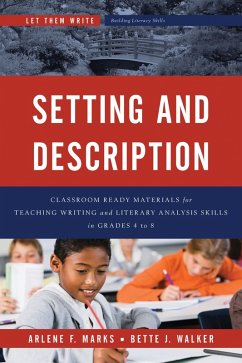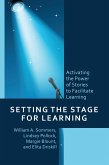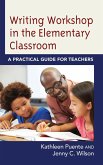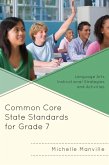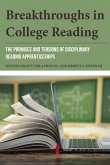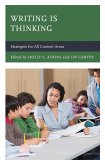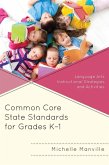Arlene F. Marks, Bette J. Walker
Setting and Description (eBook, ePUB)
Classroom Ready Materials for Teaching Writing and Literary Analysis Skills in Grades 4 to 8
43,95 €
43,95 €
inkl. MwSt.
Sofort per Download lieferbar

22 °P sammeln
43,95 €
Als Download kaufen

43,95 €
inkl. MwSt.
Sofort per Download lieferbar

22 °P sammeln
Jetzt verschenken
Alle Infos zum eBook verschenken
43,95 €
inkl. MwSt.
Sofort per Download lieferbar
Alle Infos zum eBook verschenken

22 °P sammeln
Arlene F. Marks, Bette J. Walker
Setting and Description (eBook, ePUB)
Classroom Ready Materials for Teaching Writing and Literary Analysis Skills in Grades 4 to 8
- Format: ePub
- Merkliste
- Auf die Merkliste
- Bewerten Bewerten
- Teilen
- Produkt teilen
- Produkterinnerung
- Produkterinnerung

Bitte loggen Sie sich zunächst in Ihr Kundenkonto ein oder registrieren Sie sich bei
bücher.de, um das eBook-Abo tolino select nutzen zu können.
Hier können Sie sich einloggen
Hier können Sie sich einloggen
Sie sind bereits eingeloggt. Klicken Sie auf 2. tolino select Abo, um fortzufahren.

Bitte loggen Sie sich zunächst in Ihr Kundenkonto ein oder registrieren Sie sich bei bücher.de, um das eBook-Abo tolino select nutzen zu können.
The Let Them Write Series is a classroom-tested, teacher-friendly resource for Language Arts teachers of grades 4 through 8. The program is organized in nine sections, each presenting a buffet of from five to nine 1- or 2-week modules. Each classroom-ready module consists of a series of comprehensive, easy-to-follow lesson plans complete with reproducible handouts and cross-curricular extensions, together creating a proven successful template for the teaching of writing and literary analysis skills. Setting and Description focuses on the effective use of descriptive writing techniques to…mehr
- Geräte: eReader
- mit Kopierschutz
- eBook Hilfe
- Größe: 2.75MB
Andere Kunden interessierten sich auch für
![Setting the Stage for Learning (eBook, ePUB) Setting the Stage for Learning (eBook, ePUB)]() William A. SommersSetting the Stage for Learning (eBook, ePUB)21,95 €
William A. SommersSetting the Stage for Learning (eBook, ePUB)21,95 €![Writing Workshop in the Elementary Classroom (eBook, ePUB) Writing Workshop in the Elementary Classroom (eBook, ePUB)]() Kathleen PuenteWriting Workshop in the Elementary Classroom (eBook, ePUB)21,95 €
Kathleen PuenteWriting Workshop in the Elementary Classroom (eBook, ePUB)21,95 €![Using Informational Text to Teach A Raisin in the Sun (eBook, ePUB) Using Informational Text to Teach A Raisin in the Sun (eBook, ePUB)]() Audrey FischUsing Informational Text to Teach A Raisin in the Sun (eBook, ePUB)35,95 €
Audrey FischUsing Informational Text to Teach A Raisin in the Sun (eBook, ePUB)35,95 €![Common Core State Standards for Grade 7 (eBook, ePUB) Common Core State Standards for Grade 7 (eBook, ePUB)]() Michelle ManvilleCommon Core State Standards for Grade 7 (eBook, ePUB)33,95 €
Michelle ManvilleCommon Core State Standards for Grade 7 (eBook, ePUB)33,95 €![Breakthroughs in College Reading (eBook, ePUB) Breakthroughs in College Reading (eBook, ePUB)]() Breakthroughs in College Reading (eBook, ePUB)26,95 €
Breakthroughs in College Reading (eBook, ePUB)26,95 €![Writing Is Thinking (eBook, ePUB) Writing Is Thinking (eBook, ePUB)]() Writing Is Thinking (eBook, ePUB)21,95 €
Writing Is Thinking (eBook, ePUB)21,95 €![Common Core State Standards for Grades K-1 (eBook, ePUB) Common Core State Standards for Grades K-1 (eBook, ePUB)]() Michelle ManvilleCommon Core State Standards for Grades K-1 (eBook, ePUB)17,95 €
Michelle ManvilleCommon Core State Standards for Grades K-1 (eBook, ePUB)17,95 €-
-
-
The Let Them Write Series is a classroom-tested, teacher-friendly resource for Language Arts teachers of grades 4 through 8. The program is organized in nine sections, each presenting a buffet of from five to nine 1- or 2-week modules. Each classroom-ready module consists of a series of comprehensive, easy-to-follow lesson plans complete with reproducible handouts and cross-curricular extensions, together creating a proven successful template for the teaching of writing and literary analysis skills. Setting and Description focuses on the effective use of descriptive writing techniques to depict a story setting. Students practice first-drafting, editing, polishing and sharing original scenes and stories set in realistically described times and places. The textcan be implemented in the classroom alone or in tandem with the two other titles in the Let Them Write Series -PLOT BUILDING and CHARACTER DEVELOPMENT. Also of interest for classroom teachers is the Literacy: Made for All Series WORDSMITHING: Classroom Ready Materials for Teaching Nonfiction Writing and Analysis Skills in the High School Grades ENJOYING LITERATURE: Classroom Ready Materials for Teaching Fiction and Poetry Analysis Skills in the High School Grades STORY CRAFTING: Classroom Ready Materials for Teaching Fiction Writing in the High School Grades
Produktdetails
- Produktdetails
- Verlag: Bloomsbury eBooks US
- Seitenzahl: 160
- Erscheinungstermin: 25. September 2015
- Englisch
- ISBN-13: 9781475818437
- Artikelnr.: 44831961
- Verlag: Bloomsbury eBooks US
- Seitenzahl: 160
- Erscheinungstermin: 25. September 2015
- Englisch
- ISBN-13: 9781475818437
- Artikelnr.: 44831961
- Herstellerkennzeichnung Die Herstellerinformationen sind derzeit nicht verfügbar.
Arlene F. Marks holds degrees in Modern Languages and Education from the University of Toronto and has twenty years of experience teaching high school English, Literacy and Writer's Craft at all levels from Pre-Advanced Placement to Remedial. Arlene is the author of From First Word to Last (2013, Legacy Books Press) and the LITERACY: MADE FOR ALL series (2014, R & L Education). She welcomes visitors to her web site, www.thewritersnest.ca.
INTRODUCTION TO LET THEM WRITE
Messages from the authors
How to implement this program
The aims and objectives of this program
How to implement Let Them Read
Writing a literary essay
The aims and objectives of Let Them Read
Setting up a writer-friendly classroom
Authors need a writing plan
Publishing students' work
NCCS Anchors addressed
SECTION 1: SETTING THE SCENE
SKILL 1: DESCRIBING AN INDOORS SETTING
Students will practice using their descriptive writing skills to create a
realistic indoor setting for a scene or story, in the process becoming more
observant about their real life surroundings.
Reproducibles/Media:STR 1--MY SETTING DETAILS Worksheet
STR 2-SETTING PURPOSES Worksheet
SKILL 2: DESCRIBING AN OUTDOORS SETTING
As students practice using their descriptive writing skills to create a
realistic outdoor setting for a scene or story, they may become more aware
of the natural world around them.
SKILL 3: DESCRIBING AN OCCASIONALLY VISITED LOCATION
Students will practice creating a realistic story setting using their
descriptive writing skills, in the process increasing their bank of
descriptive vocabulary.
SKILL 4: DESCRIBING A MODE OF TRANSPORTATION
As students practice describing the interior of a transportation vehicle,
they will also be expanding their active vocabulary.
SKILL 5: REVEALING SETTING TO THE READER
Young authors will learn and practice one effective way to include setting
details in the introduction to a scene or story.
Reproducibles/Media:STR 3--REVEALING SETTING TO THE READER
SECTION 2: INCLUDING SENSORY DETAIL
SKILL 1: USING THE SENSE OF SMELLAs young authors become aware of and
familiar with a variety of different smells, they will also increase their
active vocabulary by practicing different ways to describe them.
Reproducibles/Media:STR 4--EXAMPLE PARAGRAPHS SHEETSTR 5--SENSE OF SMELL
CHARTSKILL 2: USING THE SENSE OF TOUCHIn order to make their writing come
alive with sensory details, students will experience a variety of different
textures and practice ways to describe them.
Reproducibles/Media:STR 6--EXAMPLE PARAGRAPHS SHEETSTR 7--SENSE OF TOUCH
CHARTSKILL 3: USING THE SENSE OF TASTEYoung authors will learn about and
practice making their writing more vivid by including interesting
descriptions of taste where appropriate.
Reproducibles/Media:STR 8--EXAMPLE PARAGRAPHS SHEET STR 9--SENSE OF TASTE
CHARTSKILL 4: USING THE SENSE OF HEARINGStudents will practice listening to
and describing a variety of sounds in order to enrich their writing with
authentic auditory details. In the process, they will become more aware of
their everyday environment.
Reproducibles/Media:STR 10--EXAMPLE PARAGRAPHS SHEET
STR 11--SENSE OF HEARING CHART
SKILL 5: USING THE SENSE OF SIGHT
Young authors will hone their observational skills as they learn how to
select those details which will help a reader to visualize what an author
is describing.
SKILL 6: ACTION DESCRIPTIONAs students practice using colorful verbs to
make action scenes come alive for a reader, they will also be learning how
to use a thesaurus and dictionary to expand their active vocabulary.
Reproducibles/Media:STR 12-ACTION DESCRIPTION PATTERN A WORKSHEET STR
13-ACTION DESCRIPTION PATTERN B WORKSHEET
SECTION 3: INCLUDING FIGURATIVE LANGUAGE
SKILL 1: SIMILES TO DESCRIBE APPEARANCESYoung authors will learn about and
practice making their descriptive writing more interesting and powerful
through the use of simile, a figurative comparison.
Reproducibles/Media:STR 14--SIMILES TO DESCRIBE APPEARANCES WorksheetSKILL
2: SIMILES TO DESCRIBE ACTIONSYoung authors will practice using simile to
make a character's actions easier for a reader to visualize, in the process
adding strength and drama to their writing.
Reproducibles/Media:STR 15-SIMILES TO DESCRIBE ACTIONS Worksheet SKILL 3:
USING METAPHORS Students will learn about and practice using metaphor to
paint vivid language pictures in a reader's mind.
Reproducibles/Media:STR 16--METAPHORS WORKSHEETSKILL 4: USING
ONOMATOPOEIAAs young authors practice including in their descriptions words
that are interesting to listen to as well as read, they will increase their
sensitivity to the music of language.
SKILL 5: USING SYNESTHESIAStudents will learn how to make their
descriptions memorable by substituting one sense for another.
Reproducibles/Media:STR 17--SYNESTHESIA WORKSHEET
Messages from the authors
How to implement this program
The aims and objectives of this program
How to implement Let Them Read
Writing a literary essay
The aims and objectives of Let Them Read
Setting up a writer-friendly classroom
Authors need a writing plan
Publishing students' work
NCCS Anchors addressed
SECTION 1: SETTING THE SCENE
SKILL 1: DESCRIBING AN INDOORS SETTING
Students will practice using their descriptive writing skills to create a
realistic indoor setting for a scene or story, in the process becoming more
observant about their real life surroundings.
Reproducibles/Media:STR 1--MY SETTING DETAILS Worksheet
STR 2-SETTING PURPOSES Worksheet
SKILL 2: DESCRIBING AN OUTDOORS SETTING
As students practice using their descriptive writing skills to create a
realistic outdoor setting for a scene or story, they may become more aware
of the natural world around them.
SKILL 3: DESCRIBING AN OCCASIONALLY VISITED LOCATION
Students will practice creating a realistic story setting using their
descriptive writing skills, in the process increasing their bank of
descriptive vocabulary.
SKILL 4: DESCRIBING A MODE OF TRANSPORTATION
As students practice describing the interior of a transportation vehicle,
they will also be expanding their active vocabulary.
SKILL 5: REVEALING SETTING TO THE READER
Young authors will learn and practice one effective way to include setting
details in the introduction to a scene or story.
Reproducibles/Media:STR 3--REVEALING SETTING TO THE READER
SECTION 2: INCLUDING SENSORY DETAIL
SKILL 1: USING THE SENSE OF SMELLAs young authors become aware of and
familiar with a variety of different smells, they will also increase their
active vocabulary by practicing different ways to describe them.
Reproducibles/Media:STR 4--EXAMPLE PARAGRAPHS SHEETSTR 5--SENSE OF SMELL
CHARTSKILL 2: USING THE SENSE OF TOUCHIn order to make their writing come
alive with sensory details, students will experience a variety of different
textures and practice ways to describe them.
Reproducibles/Media:STR 6--EXAMPLE PARAGRAPHS SHEETSTR 7--SENSE OF TOUCH
CHARTSKILL 3: USING THE SENSE OF TASTEYoung authors will learn about and
practice making their writing more vivid by including interesting
descriptions of taste where appropriate.
Reproducibles/Media:STR 8--EXAMPLE PARAGRAPHS SHEET STR 9--SENSE OF TASTE
CHARTSKILL 4: USING THE SENSE OF HEARINGStudents will practice listening to
and describing a variety of sounds in order to enrich their writing with
authentic auditory details. In the process, they will become more aware of
their everyday environment.
Reproducibles/Media:STR 10--EXAMPLE PARAGRAPHS SHEET
STR 11--SENSE OF HEARING CHART
SKILL 5: USING THE SENSE OF SIGHT
Young authors will hone their observational skills as they learn how to
select those details which will help a reader to visualize what an author
is describing.
SKILL 6: ACTION DESCRIPTIONAs students practice using colorful verbs to
make action scenes come alive for a reader, they will also be learning how
to use a thesaurus and dictionary to expand their active vocabulary.
Reproducibles/Media:STR 12-ACTION DESCRIPTION PATTERN A WORKSHEET STR
13-ACTION DESCRIPTION PATTERN B WORKSHEET
SECTION 3: INCLUDING FIGURATIVE LANGUAGE
SKILL 1: SIMILES TO DESCRIBE APPEARANCESYoung authors will learn about and
practice making their descriptive writing more interesting and powerful
through the use of simile, a figurative comparison.
Reproducibles/Media:STR 14--SIMILES TO DESCRIBE APPEARANCES WorksheetSKILL
2: SIMILES TO DESCRIBE ACTIONSYoung authors will practice using simile to
make a character's actions easier for a reader to visualize, in the process
adding strength and drama to their writing.
Reproducibles/Media:STR 15-SIMILES TO DESCRIBE ACTIONS Worksheet SKILL 3:
USING METAPHORS Students will learn about and practice using metaphor to
paint vivid language pictures in a reader's mind.
Reproducibles/Media:STR 16--METAPHORS WORKSHEETSKILL 4: USING
ONOMATOPOEIAAs young authors practice including in their descriptions words
that are interesting to listen to as well as read, they will increase their
sensitivity to the music of language.
SKILL 5: USING SYNESTHESIAStudents will learn how to make their
descriptions memorable by substituting one sense for another.
Reproducibles/Media:STR 17--SYNESTHESIA WORKSHEET
INTRODUCTION TO LET THEM WRITE
Messages from the authors
How to implement this program
The aims and objectives of this program
How to implement Let Them Read
Writing a literary essay
The aims and objectives of Let Them Read
Setting up a writer-friendly classroom
Authors need a writing plan
Publishing students' work
NCCS Anchors addressed
SECTION 1: SETTING THE SCENE
SKILL 1: DESCRIBING AN INDOORS SETTING
Students will practice using their descriptive writing skills to create a
realistic indoor setting for a scene or story, in the process becoming more
observant about their real life surroundings.
Reproducibles/Media:STR 1--MY SETTING DETAILS Worksheet
STR 2-SETTING PURPOSES Worksheet
SKILL 2: DESCRIBING AN OUTDOORS SETTING
As students practice using their descriptive writing skills to create a
realistic outdoor setting for a scene or story, they may become more aware
of the natural world around them.
SKILL 3: DESCRIBING AN OCCASIONALLY VISITED LOCATION
Students will practice creating a realistic story setting using their
descriptive writing skills, in the process increasing their bank of
descriptive vocabulary.
SKILL 4: DESCRIBING A MODE OF TRANSPORTATION
As students practice describing the interior of a transportation vehicle,
they will also be expanding their active vocabulary.
SKILL 5: REVEALING SETTING TO THE READER
Young authors will learn and practice one effective way to include setting
details in the introduction to a scene or story.
Reproducibles/Media:STR 3--REVEALING SETTING TO THE READER
SECTION 2: INCLUDING SENSORY DETAIL
SKILL 1: USING THE SENSE OF SMELLAs young authors become aware of and
familiar with a variety of different smells, they will also increase their
active vocabulary by practicing different ways to describe them.
Reproducibles/Media:STR 4--EXAMPLE PARAGRAPHS SHEETSTR 5--SENSE OF SMELL
CHARTSKILL 2: USING THE SENSE OF TOUCHIn order to make their writing come
alive with sensory details, students will experience a variety of different
textures and practice ways to describe them.
Reproducibles/Media:STR 6--EXAMPLE PARAGRAPHS SHEETSTR 7--SENSE OF TOUCH
CHARTSKILL 3: USING THE SENSE OF TASTEYoung authors will learn about and
practice making their writing more vivid by including interesting
descriptions of taste where appropriate.
Reproducibles/Media:STR 8--EXAMPLE PARAGRAPHS SHEET STR 9--SENSE OF TASTE
CHARTSKILL 4: USING THE SENSE OF HEARINGStudents will practice listening to
and describing a variety of sounds in order to enrich their writing with
authentic auditory details. In the process, they will become more aware of
their everyday environment.
Reproducibles/Media:STR 10--EXAMPLE PARAGRAPHS SHEET
STR 11--SENSE OF HEARING CHART
SKILL 5: USING THE SENSE OF SIGHT
Young authors will hone their observational skills as they learn how to
select those details which will help a reader to visualize what an author
is describing.
SKILL 6: ACTION DESCRIPTIONAs students practice using colorful verbs to
make action scenes come alive for a reader, they will also be learning how
to use a thesaurus and dictionary to expand their active vocabulary.
Reproducibles/Media:STR 12-ACTION DESCRIPTION PATTERN A WORKSHEET STR
13-ACTION DESCRIPTION PATTERN B WORKSHEET
SECTION 3: INCLUDING FIGURATIVE LANGUAGE
SKILL 1: SIMILES TO DESCRIBE APPEARANCESYoung authors will learn about and
practice making their descriptive writing more interesting and powerful
through the use of simile, a figurative comparison.
Reproducibles/Media:STR 14--SIMILES TO DESCRIBE APPEARANCES WorksheetSKILL
2: SIMILES TO DESCRIBE ACTIONSYoung authors will practice using simile to
make a character's actions easier for a reader to visualize, in the process
adding strength and drama to their writing.
Reproducibles/Media:STR 15-SIMILES TO DESCRIBE ACTIONS Worksheet SKILL 3:
USING METAPHORS Students will learn about and practice using metaphor to
paint vivid language pictures in a reader's mind.
Reproducibles/Media:STR 16--METAPHORS WORKSHEETSKILL 4: USING
ONOMATOPOEIAAs young authors practice including in their descriptions words
that are interesting to listen to as well as read, they will increase their
sensitivity to the music of language.
SKILL 5: USING SYNESTHESIAStudents will learn how to make their
descriptions memorable by substituting one sense for another.
Reproducibles/Media:STR 17--SYNESTHESIA WORKSHEET
Messages from the authors
How to implement this program
The aims and objectives of this program
How to implement Let Them Read
Writing a literary essay
The aims and objectives of Let Them Read
Setting up a writer-friendly classroom
Authors need a writing plan
Publishing students' work
NCCS Anchors addressed
SECTION 1: SETTING THE SCENE
SKILL 1: DESCRIBING AN INDOORS SETTING
Students will practice using their descriptive writing skills to create a
realistic indoor setting for a scene or story, in the process becoming more
observant about their real life surroundings.
Reproducibles/Media:STR 1--MY SETTING DETAILS Worksheet
STR 2-SETTING PURPOSES Worksheet
SKILL 2: DESCRIBING AN OUTDOORS SETTING
As students practice using their descriptive writing skills to create a
realistic outdoor setting for a scene or story, they may become more aware
of the natural world around them.
SKILL 3: DESCRIBING AN OCCASIONALLY VISITED LOCATION
Students will practice creating a realistic story setting using their
descriptive writing skills, in the process increasing their bank of
descriptive vocabulary.
SKILL 4: DESCRIBING A MODE OF TRANSPORTATION
As students practice describing the interior of a transportation vehicle,
they will also be expanding their active vocabulary.
SKILL 5: REVEALING SETTING TO THE READER
Young authors will learn and practice one effective way to include setting
details in the introduction to a scene or story.
Reproducibles/Media:STR 3--REVEALING SETTING TO THE READER
SECTION 2: INCLUDING SENSORY DETAIL
SKILL 1: USING THE SENSE OF SMELLAs young authors become aware of and
familiar with a variety of different smells, they will also increase their
active vocabulary by practicing different ways to describe them.
Reproducibles/Media:STR 4--EXAMPLE PARAGRAPHS SHEETSTR 5--SENSE OF SMELL
CHARTSKILL 2: USING THE SENSE OF TOUCHIn order to make their writing come
alive with sensory details, students will experience a variety of different
textures and practice ways to describe them.
Reproducibles/Media:STR 6--EXAMPLE PARAGRAPHS SHEETSTR 7--SENSE OF TOUCH
CHARTSKILL 3: USING THE SENSE OF TASTEYoung authors will learn about and
practice making their writing more vivid by including interesting
descriptions of taste where appropriate.
Reproducibles/Media:STR 8--EXAMPLE PARAGRAPHS SHEET STR 9--SENSE OF TASTE
CHARTSKILL 4: USING THE SENSE OF HEARINGStudents will practice listening to
and describing a variety of sounds in order to enrich their writing with
authentic auditory details. In the process, they will become more aware of
their everyday environment.
Reproducibles/Media:STR 10--EXAMPLE PARAGRAPHS SHEET
STR 11--SENSE OF HEARING CHART
SKILL 5: USING THE SENSE OF SIGHT
Young authors will hone their observational skills as they learn how to
select those details which will help a reader to visualize what an author
is describing.
SKILL 6: ACTION DESCRIPTIONAs students practice using colorful verbs to
make action scenes come alive for a reader, they will also be learning how
to use a thesaurus and dictionary to expand their active vocabulary.
Reproducibles/Media:STR 12-ACTION DESCRIPTION PATTERN A WORKSHEET STR
13-ACTION DESCRIPTION PATTERN B WORKSHEET
SECTION 3: INCLUDING FIGURATIVE LANGUAGE
SKILL 1: SIMILES TO DESCRIBE APPEARANCESYoung authors will learn about and
practice making their descriptive writing more interesting and powerful
through the use of simile, a figurative comparison.
Reproducibles/Media:STR 14--SIMILES TO DESCRIBE APPEARANCES WorksheetSKILL
2: SIMILES TO DESCRIBE ACTIONSYoung authors will practice using simile to
make a character's actions easier for a reader to visualize, in the process
adding strength and drama to their writing.
Reproducibles/Media:STR 15-SIMILES TO DESCRIBE ACTIONS Worksheet SKILL 3:
USING METAPHORS Students will learn about and practice using metaphor to
paint vivid language pictures in a reader's mind.
Reproducibles/Media:STR 16--METAPHORS WORKSHEETSKILL 4: USING
ONOMATOPOEIAAs young authors practice including in their descriptions words
that are interesting to listen to as well as read, they will increase their
sensitivity to the music of language.
SKILL 5: USING SYNESTHESIAStudents will learn how to make their
descriptions memorable by substituting one sense for another.
Reproducibles/Media:STR 17--SYNESTHESIA WORKSHEET
